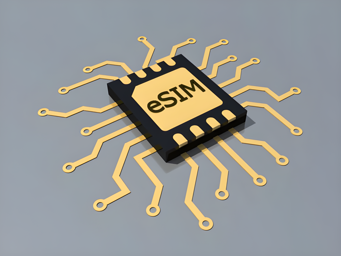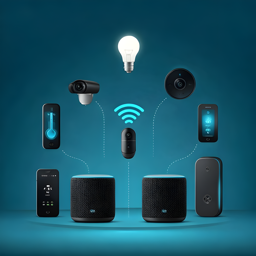Secure ESP32 IoT: HTTPS, MQTT, and Network Hardening
Efficient OTA Monitoring with MQTT for Reliable IoT Updates
Over-the-air (OTA Implementing Over-the-Air (OTA) Updates via Wi-Fi on ESP32Learn how to implement secure and reliable OTA updates on ESP32 for enhanced IoT performance, easy updates, and rollback capability without physical access.) updates are critical for maintaining IoT deployments, but without real-time monitoring, failed updates can leave devices inoperable. This guide dives into tracking OTA progress, errors, and device states using MQTT
Implementing Over-the-Air (OTA) Updates via Wi-Fi on ESP32Learn how to implement secure and reliable OTA updates on ESP32 for enhanced IoT performance, easy updates, and rollback capability without physical access.) updates are critical for maintaining IoT deployments, but without real-time monitoring, failed updates can leave devices inoperable. This guide dives into tracking OTA progress, errors, and device states using MQTT Connecting ESP32 to Cloud Services via Wi-FiDiscover how to connect your ESP32 to AWS, Azure, and Google Cloud using secure Wi-Fi. This guide covers setup, error handling, and low power strategies., enabling centralized fleet management and proactive troubleshooting
Connecting ESP32 to Cloud Services via Wi-FiDiscover how to connect your ESP32 to AWS, Azure, and Google Cloud using secure Wi-Fi. This guide covers setup, error handling, and low power strategies., enabling centralized fleet management and proactive troubleshooting Connecting ESP32 to Cloud Services via Wi-FiDiscover how to connect your ESP32 to AWS, Azure, and Google Cloud using secure Wi-Fi. This guide covers setup, error handling, and low power strategies.. Learn how to implement scalable monitoring, handle errors, and ensure reliable updates across your IoT ecosystem.
Connecting ESP32 to Cloud Services via Wi-FiDiscover how to connect your ESP32 to AWS, Azure, and Google Cloud using secure Wi-Fi. This guide covers setup, error handling, and low power strategies.. Learn how to implement scalable monitoring, handle errors, and ensure reliable updates across your IoT ecosystem.
Table of Contents🔗
- Why Monitor OTA Updates
 Implementing Over-the-Air (OTA) Updates via Wi-Fi on ESP32Learn how to implement secure and reliable OTA updates on ESP32 for enhanced IoT performance, easy updates, and rollback capability without physical access.?
Implementing Over-the-Air (OTA) Updates via Wi-Fi on ESP32Learn how to implement secure and reliable OTA updates on ESP32 for enhanced IoT performance, easy updates, and rollback capability without physical access.? - MQTT
 Connecting ESP32 to Cloud Services via Wi-FiDiscover how to connect your ESP32 to AWS, Azure, and Google Cloud using secure Wi-Fi. This guide covers setup, error handling, and low power strategies. as a Monitoring Backbone
Connecting ESP32 to Cloud Services via Wi-FiDiscover how to connect your ESP32 to AWS, Azure, and Google Cloud using secure Wi-Fi. This guide covers setup, error handling, and low power strategies. as a Monitoring Backbone - OTA Update
 Dual-Partition OTA: Safe Rollback and A/B Testing on ESP32Explore the ESP32 dual-partition OTA update process, ensuring safe rollbacks and effective A/B testing for reliable IoT deployments. Lifecycle
Dual-Partition OTA: Safe Rollback and A/B Testing on ESP32Explore the ESP32 dual-partition OTA update process, ensuring safe rollbacks and effective A/B testing for reliable IoT deployments. Lifecycle - Setting Up MQTT
 Connecting ESP32 to Cloud Services via Wi-FiDiscover how to connect your ESP32 to AWS, Azure, and Google Cloud using secure Wi-Fi. This guide covers setup, error handling, and low power strategies. for OTA Monitoring
Connecting ESP32 to Cloud Services via Wi-FiDiscover how to connect your ESP32 to AWS, Azure, and Google Cloud using secure Wi-Fi. This guide covers setup, error handling, and low power strategies. for OTA Monitoring - Designing MQTT
 Connecting ESP32 to Cloud Services via Wi-FiDiscover how to connect your ESP32 to AWS, Azure, and Google Cloud using secure Wi-Fi. This guide covers setup, error handling, and low power strategies. Topics and Payloads
Connecting ESP32 to Cloud Services via Wi-FiDiscover how to connect your ESP32 to AWS, Azure, and Google Cloud using secure Wi-Fi. This guide covers setup, error handling, and low power strategies. Topics and Payloads - Implementing OTA
 Implementing Over-the-Air (OTA) Updates via Wi-Fi on ESP32Learn how to implement secure and reliable OTA updates on ESP32 for enhanced IoT performance, easy updates, and rollback capability without physical access. Status Tracking
Implementing Over-the-Air (OTA) Updates via Wi-Fi on ESP32Learn how to implement secure and reliable OTA updates on ESP32 for enhanced IoT performance, easy updates, and rollback capability without physical access. Status Tracking - Tracking Progress: Topics and Payloads
- Error Handling
 Connecting ESP32 to Cloud Services via Wi-FiDiscover how to connect your ESP32 to AWS, Azure, and Google Cloud using secure Wi-Fi. This guide covers setup, error handling, and low power strategies. and Recovery Strategies
Connecting ESP32 to Cloud Services via Wi-FiDiscover how to connect your ESP32 to AWS, Azure, and Google Cloud using secure Wi-Fi. This guide covers setup, error handling, and low power strategies. and Recovery Strategies - Best Practices
 Zigbee Green Power: Ultra-Low-Power Energy Harvesting SolutionsDiscover how ZGP enables battery-free IoT devices through energy harvesting with ESP32 integrations, supporting smart home and industrial applications. for Scalable Monitoring
Zigbee Green Power: Ultra-Low-Power Energy Harvesting SolutionsDiscover how ZGP enables battery-free IoT devices through energy harvesting with ESP32 integrations, supporting smart home and industrial applications. for Scalable Monitoring - Case Study
 Cost Analysis: Total Ownership for ESP32 Connectivity SolutionsUnlock cost savings with ESP32 IoT solutions. This guide reveals how to balance hardware, connectivity, power, and maintenance costs to master TCO.: Smart Agriculture OTA Fleet
Cost Analysis: Total Ownership for ESP32 Connectivity SolutionsUnlock cost savings with ESP32 IoT solutions. This guide reveals how to balance hardware, connectivity, power, and maintenance costs to master TCO.: Smart Agriculture OTA Fleet - Practical Example: ESP32
 Setting Up ESP32 as a Wi-Fi Access PointMaster ESP32 AP configuration with our step-by-step guide. Set up a secure, local IoT network using practical code examples and optimization tips. OTA Monitoring
Setting Up ESP32 as a Wi-Fi Access PointMaster ESP32 AP configuration with our step-by-step guide. Set up a secure, local IoT network using practical code examples and optimization tips. OTA Monitoring
Why Monitor OTA Updates?🔗
OTA updates Implementing Over-the-Air (OTA) Updates via Wi-Fi on ESP32Learn how to implement secure and reliable OTA updates on ESP32 for enhanced IoT performance, easy updates, and rollback capability without physical access. are essential for maintaining IoT device functionality and security. However, risks like network interruptions, insufficient storage, or corrupted firmware can lead to failed updates. Monitoring enables:
Implementing Over-the-Air (OTA) Updates via Wi-Fi on ESP32Learn how to implement secure and reliable OTA updates on ESP32 for enhanced IoT performance, easy updates, and rollback capability without physical access. are essential for maintaining IoT device functionality and security. However, risks like network interruptions, insufficient storage, or corrupted firmware can lead to failed updates. Monitoring enables:
- Real-time progress tracking to confirm updates proceed as expected.
- Immediate error identification and corrective actions.
- Centralized fleet management to ensure consistent firmware versions.
- Reliability improvements via historical logging and failure pattern analysis.
MQTT as a Monitoring Backbone🔗
MQTT Connecting ESP32 to Cloud Services via Wi-FiDiscover how to connect your ESP32 to AWS, Azure, and Google Cloud using secure Wi-Fi. This guide covers setup, error handling, and low power strategies.’s pub/sub model is ideal for OTA monitoring due to:
Connecting ESP32 to Cloud Services via Wi-FiDiscover how to connect your ESP32 to AWS, Azure, and Google Cloud using secure Wi-Fi. This guide covers setup, error handling, and low power strategies.’s pub/sub model is ideal for OTA monitoring due to:
- Low bandwidth
 Adaptive Data Rate (ADR) Optimization for LoRaWAN on ESP32Optimize your IoT network with our ADR tutorial for ESP32 in LoRaWAN. Learn dynamic transmission tuning, power management, and troubleshooting strategies. usage: Efficient for constrained networks.
Adaptive Data Rate (ADR) Optimization for LoRaWAN on ESP32Optimize your IoT network with our ADR tutorial for ESP32 in LoRaWAN. Learn dynamic transmission tuning, power management, and troubleshooting strategies. usage: Efficient for constrained networks. - Real-time updates: Instant notifications via retained messages.
- Scalability: Decentralized architecture supports thousands of devices.
- Flexible topic hierarchy: Enables granular monitoring by device, phase, or error type.
OTA Update Lifecycle🔗
Understanding the OTA Implementing Over-the-Air (OTA) Updates via Wi-Fi on ESP32Learn how to implement secure and reliable OTA updates on ESP32 for enhanced IoT performance, easy updates, and rollback capability without physical access. phases ensures effective monitoring:
Implementing Over-the-Air (OTA) Updates via Wi-Fi on ESP32Learn how to implement secure and reliable OTA updates on ESP32 for enhanced IoT performance, easy updates, and rollback capability without physical access. phases ensures effective monitoring:
1. Initialization: Verify firmware integrity before starting.
2. Download: Transfer firmware binary in chunks.
3. Installation: Write firmware to flash memory.
4. Verification: Validate checksums and reboot.
Setting Up MQTT for OTA Monitoring🔗
Install MQTT Libraries
Use PubSubClient or ESP-MQTT for ESP32 Connecting ESP32 to Cloud Services via Wi-FiDiscover how to connect your ESP32 to AWS, Azure, and Google Cloud using secure Wi-Fi. This guide covers setup, error handling, and low power strategies.
Connecting ESP32 to Cloud Services via Wi-FiDiscover how to connect your ESP32 to AWS, Azure, and Google Cloud using secure Wi-Fi. This guide covers setup, error handling, and low power strategies. Setting Up ESP32 as a Wi-Fi Access PointMaster ESP32 AP configuration with our step-by-step guide. Set up a secure, local IoT network using practical code examples and optimization tips.:
Setting Up ESP32 as a Wi-Fi Access PointMaster ESP32 AP configuration with our step-by-step guide. Set up a secure, local IoT network using practical code examples and optimization tips.:
#include <WiFi.h>
#include <PubSubClient.h>
WiFiClient espClient;
PubSubClient mqttClient(espClient);
Connect to an MQTT Broker
void connectMQTT() {
mqttClient.setServer("broker.hivemq.com", 1883);
while (!mqttClient.connected()) {
if (mqttClient.connect("ESP32Client")) {
Serial.println("Connected to MQTT broker");
} else {
delay(2000);
}
}
}
Secure Communication
WiFiClientSecure wifiClient;
wifiClient.setCACert(aws_root_ca); // Use TLS for AWS IoT Core
Designing MQTT Topics and Payloads🔗
Topic Structure Example
device/{DEVICE_ID}/ota/status # Current state (e.g., "downloading")
device/{DEVICE_ID}/ota/progress # Percentage completion
device/{DEVICE_ID}/ota/error # Error codes and descriptions
JSON Payload Example
{
"device_id": "ESP32-123",
"timestamp": "2023-10-05T14:48:00Z",
"phase": "download",
"status": "in_progress",
"progress": 45,
"error": null
}
Implementing OTA Status Tracking🔗
Using ArduinoOTA (Article 1 Approach)
#include <ArduinoOTA.h>
void setupOTA() {
ArduinoOTA
.onStart([]() {
mqttClient.publish("device/ESP32-123/ota/status", "start");
})
.onProgress([](unsigned progress, unsigned total) {
int percent = (progress * 100) / total;
mqttClient.publish("device/ESP32-123/ota/progress", String(percent).c_str());
})
.onError([](ota_error_t error) {
mqttClient.publish("device/ESP32-123/ota/error", String(error).c_str());
});
ArduinoOTA.begin();
}
Using Update Class (Article 2 Approach)
#include <Update.h>
void onOTAProgress(size_t progress, size_t total) {
int percent = (progress * 100) / total;
mqttClient.publish("esp32/ota/progress", String(percent).c_str());
}
void setup() {
Update.onProgress(onOTAProgress);
}
Tracking Progress: Topics and Payloads🔗
| Status | MQTT Payload Example | Description |
|---|---|---|
downloading | {"state":"downloading"} | Firmware binary transfer in progress |
verifying | {"state":"verifying"} | SHA256 checksum validation |
applying | {"state":"applying"} | Writing to flash partition |
Progress Granularity Tips:
- Throttle updates to 1 message/sec for large firmware (>1MB).
- Use QoS 1 for guaranteed delivery:
mqttClient.publish("device/ESP32-123/ota/progress", payload, true, 1);
Error Handling and Recovery Strategies🔗
| Error Code | Description | Automated Response |
|---|---|---|
OTA_AUTH_ERROR | Signature verification failed | Rollback via retained message |
OTA_BEGIN_ERROR | Insufficient flash memory | Trigger cleanup script |
OTA_RECEIVE_ERROR | Network instability | Resume download with HTTP range requests |
{
"code": 7,
"message": "Flash write failed",
"retryable": true
}
Best Practices for Scalable Monitoring🔗
1. Retained Messages: Ensure new subscribers receive the latest state.
mqttClient.publish("device/ESP32-123/ota/status", "idle", true);
2. QoS Levels: Use QoS 1 for progress, QoS 2 for critical errors.
3. Throttling: Limit messages to prevent broker flooding.
4. Security: Always use TLS and authentication.
5. Dashboards: Integrate with Node-RED or Grafana Real-Time Dashboards: Visualizing ESP32 Data in GrafanaDiscover how to create robust, secure IoT monitoring solutions by forwarding ESP32 sensor data through MQTT, InfluxDB, and real-time Grafana dashboards. for real-time insights.
Real-Time Dashboards: Visualizing ESP32 Data in GrafanaDiscover how to create robust, secure IoT monitoring solutions by forwarding ESP32 sensor data through MQTT, InfluxDB, and real-time Grafana dashboards. for real-time insights.
Case Study: Smart Agriculture OTA Fleet🔗
A vineyard deployed 200 ESP32 sensors Real-Time Dashboards: Visualizing ESP32 Data in GrafanaDiscover how to create robust, secure IoT monitoring solutions by forwarding ESP32 sensor data through MQTT, InfluxDB, and real-time Grafana dashboards. using MQTT for OTA monitoring:
Real-Time Dashboards: Visualizing ESP32 Data in GrafanaDiscover how to create robust, secure IoT monitoring solutions by forwarding ESP32 sensor data through MQTT, InfluxDB, and real-time Grafana dashboards. using MQTT for OTA monitoring:
- Broker: Mosquitto with TLS.
- Topics:
vineyard/+/otafor fleet-wide monitoring. Implementing Over-the-Air (OTA) Updates via Wi-Fi on ESP32Learn how to implement secure and reliable OTA updates on ESP32 for enhanced IoT performance, easy updates, and rollback capability without physical access./#
Implementing Over-the-Air (OTA) Updates via Wi-Fi on ESP32Learn how to implement secure and reliable OTA updates on ESP32 for enhanced IoT performance, easy updates, and rollback capability without physical access./# - Outcome:
- Reduced failed updates from 15% to 2% via automated retries.
- Debugged memory fragmentation using aggregated error logs.
Practical Example: ESP32 OTA Monitoring🔗
#include <WiFi.h>
#include <PubSubClient.h>
#include <ArduinoOTA.h>
const char* ssid = "your_wifi_ssid";
const char* password = "your_wifi_password";
WiFiClient espClient;
PubSubClient mqttClient(espClient);
void setup() {
Serial.begin(115200);
WiFi.begin(ssid, password);
while (WiFi.status() != WL_CONNECTED) delay(1000);
mqttClient.setServer("broker.hivemq.com", 1883);
while (!mqttClient.connect("ESP32Client")) delay(2000);
ArduinoOTA
.onStart([]() { mqttClient.publish("device/ESP32-123/ota/status", "start"); })
.onProgress([](unsigned p, unsigned t) {
mqttClient.publish("device/ESP32-123/ota/progress", String((p*100)/t).c_str());
})
.onError([](ota_error_t e) {
mqttClient.publish("device/ESP32-123/ota/error", String(e).c_str());
});
ArduinoOTA.begin();
}
void loop() {
ArduinoOTA.handle();
mqttClient.loop();
}
By leveraging MQTT for OTA monitoring, you gain real-time visibility into firmware updates AWS IoT Core with ESP32: X.509 Certificates and Shadow UpdatesLearn to securely connect ESP32 to AWS IoT Core using X.509 certificates and device shadows, with step-by-step instructions and best practices., minimize downtime, and ensure robust fleet management. Implement these strategies to build a resilient IoT infrastructure.
AWS IoT Core with ESP32: X.509 Certificates and Shadow UpdatesLearn to securely connect ESP32 to AWS IoT Core using X.509 certificates and device shadows, with step-by-step instructions and best practices., minimize downtime, and ensure robust fleet management. Implement these strategies to build a resilient IoT infrastructure.
Author: Marcelo V. Souza - Engenheiro de Sistemas e Entusiasta em IoT e Desenvolvimento de Software, com foco em inovação tecnológica.
References🔗
- Arduino Forum: forum.arduino.cc
- Arduino IDE Official Website: arduino.cc
- ESP-IDF Programming Guide: docs.espressif.com/projects/esp-idf
- ESP32 Arduino Core Documentation: docs.espressif.com/projects/arduino-esp32
- Espressif Documentation: docs.espressif.com

 9 months ago
9 months ago
 8 months ago
8 months ago
 8 months ago
8 months ago
 8 months ago
8 months ago
 8 months ago
8 months ago
 8 months ago
8 months ago
 8 months ago
8 months ago
 8 months ago
8 months ago
 8 months ago
8 months ago
 8 months ago
8 months ago
 8 months ago
8 months ago
 8 months ago
8 months ago
 9 months ago
9 months ago
 9 months ago
9 months ago
 9 months ago
9 months ago
 9 months ago
9 months ago
 9 months ago
9 months ago
 9 months ago
9 months ago
 9 months ago
9 months ago
 9 months ago
9 months ago
 9 months ago
9 months ago
 9 months ago
9 months ago
 9 months ago
9 months ago
 9 months ago
9 months ago
 9 months ago
9 months ago